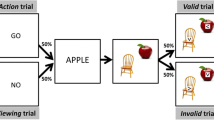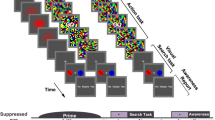Abstract
It is typically assumed that perception for action and object recognition are subserved by functionally and neuroanatomically distinct processing streams in the brain. However, recent evidence challenges this classical view and suggests an interaction between both visual processing streams. While previous studies showed an influence of object perception on action-related tasks, we investigated whether action representations facilitate visual object recognition. In order to address this question, two briefly displayed masked objects were sequentially presented, either affording congruent or incongruent motor interactions. We found superior naming accuracy for object pairs with congruent as compared to incongruent motor interactions (Experiment 1). This action priming effect indicates that action representations can facilitate object recognition. We further investigated the nature of the representations underlying this action priming effect. The effect was absent when the prime stimulus was presented as a word (Experiment 2). Thus, the action priming effect seems to rely on action representations specified by visual object information. Our findings suggest that processes of object-directed action influence object recognition.


Similar content being viewed by others
References
Baayen RH, Piepenbrock R, Gulikers L (1995) The CELEX Lexical Database (Release 2) [CD-ROM]. Linguistic Data Consortium, University of Pennsylvania [Distributor], Philadelphia
Boronat CB, Buxbaum LJ, Coslett HB, Tang K, Saffran EM, Kimberg DY, Detre JA (2005) Distinctions between manipulation and function knowledge of objects: evidence from functional magnetic resonance imaging. Brain Res Cogn Brain Res 23:361–373
Brainard DH (1997) The psychophysics toolbox. Spat Vis 10:433–436
Bub DN, Masson ME, Bukach CM (2003) Gesturing and naming: the use of functional knowledge in object identification. Psych Sci 14:467–472
Chao LL, Martin A (2000) Representation of manipulable man-made objects in the dorsal stream. Neuroimage 12:478–484
Craighero L, Fadiga L, Rizzolatti G, Umilta C (1999) Action for perception: a motor-visual attentional effect. J Exp Psychol Hum Percept Perform 25:1673–1692
Creem SH, Proffitt DR (2001) Grasping objects by their handles: a necessary interaction between cognition and action. J Exp Psychol Hum Percept Perform 27:218–228
Decety J, Perani D, Jeannerod M, Bettinardi V, Tadary B, Woods R, Mazziotta JC, Fazio F (1994) Mapping motor representations with positron emission tomography. Nature 371:600–602
Falmagne JC (1986) Psychophysical measurement and theory. In: Boff KR, Kaufman L, Thomas JP (eds) Handbook of perception and human performance, vol. 1. Wiley, New York, pp 124–127
Farah MJ, McClelland JL (1991) A computational model of semantic memory impairment: modality specificity and emergent category specificity. J Exp Psychol Gen 120:339–357
Fuster JM (2004) Upper processing stages of the perception-action cycle. Trends Cogn Sci 8:143–145
Gainotti G, Silveri MC, Daniele A, Giustolisi L (1995) Neuroanatomical correlates of category-specific impairments: A critical survey. Memory 3:247–264
Glenberg AM, Kaschak MP (2002) Grounding language in action. Psychon Bull Rev 9:558–565
Glover S, Rosenbaum DA, Graham J, Dixon P (2004) Grasping the meaning of words. Exp Brain Res 154:103–108
Goodale MA, Haffenden AM (2003) Interactions between the dorsal and ventral streams of visual processing. Adv Neurol 93:249–267
Goodale MA, Milner AD (1992) Separate visual pathways for perception and action. Trends Neurosci 15:20–25
Graf M (2006) Coordinate transformations in object recognition. Psychol Bull (in press)
Graf M, Kaping D, Bülthoff HH (2005) Orientation congruency effects for familiar objects: coordinate transformations in object recognition. Psych Sci 16:214–221
Grèzes J, Decety J (2002) Does visual perception of object afford action? Evidence from a neuroimaging study. Neuropsychologia 40:212–222
Grèzes J, Tucker M, Armony J, Ellis R, Passingham RE (2003) Objects automatically potentiate action: an fMRI study of implicit processing. Eur J Neurosci 17:2735–2740
Hauk O, Pulvermüller F (2004) Neurophysiological distinction of action words in the fronto-central cortex. Human Brain Mapp 21:191–201
Hauk O, Johnsrude I, Pulvermüller F (2004) Somatotopic representation of action words in human motor and premotor cortex. Neuron 41:301–307
Humphreys GW, Forde EME (2001) Hierarchies, similarity, and interactivity in object recognition: category-specific neuropsychological deficits. Behav Brain Sci 24:453–509
Kiefer M (2001) Perceptual and semantic sources of category-specific effects in object categorization: event-related potentials during picture and word categorization. Mem Cogn 29:100–116
Kiefer M (2002) The N400 is modulated by unconsciously perceived masked words: further evidence for an automatic spreading activation account of N400 priming effects. Brain Res Cogn Brain Res 13:27–39
Kiefer M (2005) Repetition priming modulates category-related effects on event-related potentials: further evidence for multiple cortical semantic systems. J Cogn Neurosci 17:199–211
Kiefer M, Spitzer M (2000) Time course of conscious and unconscious semantic brain activation. Neuroreport 11:2401–2407
Kiefer M, Spitzer M (2001) The limits of a distributed account of conceptual knowledge. Trends Cogn Sci 5:469–471
Martin A, Haxby JV, Lalonde FM, Wiggs CL, Ungerleider LG (1995) Discrete cortical regions associated with knowledge of color and knowledge of action. Science 270:102–105
Martin A, Wiggs CL, Ungerleider LG, Haxby JV (1996) Neural correlates of category-specific knowledge. Nature 379:649–652
Mervis CB, Rosch E (1981) Categorization of natural objects. Annu Rev Psychol 32:89–115
Milner AD, Goodale MA (1995) The visual brain in action. Oxford University Press, Oxford
Murata A, Fadiga L, Fogassi L, Gallese V, Raos V, Rizzolatti G (1997) Object representation in the ventral premotor cortex (area F5) of the monkey. J Neurophysiol 78:2226–2230
Murata A, Gallese V, Luppino G, Kaseda M, Sakata H (2000) Selectivity for the shape, size, and orientation of objects for grasping in neurons of monkey parietal area AIP. J Neurophysiol 83:2580–2601
Neely JH (1991) Semantic priming effects in visual word recognition: a selective review of currents findings and theories. In: Besner D, Humphreys G (eds) Basic processes in reading: visual word recognition. Lawrence Erlbaum, London, pp. 264–336
Noppeney U, Price CJ, Penny WD, Friston KJ (2006) Two distinct neural mechanisms for category-selective responses. Cereb Cortex 16:437–445
Pavese A, Buxbaum LJ (2002) Action matters: the role of action plans and object affordances in selection for action. Vis Cogn 9:559–590
Pelli DG (1997) The videotoolbox software for visual psychophysics: transforming numbers into movies. Spat Vis 10:437–442
Riddoch MJ, Humphreys GW, Edwards S, Baker T, Willson K (2003) Seeing the action: neuropsychological evidence for action-based effects on object selection. Nat Neurosci 6:82–89
Rizzolatti G, Fadiga L (1998) Grasping objects and grasping meanings: the dual role of monkey rostroventral premotor cortex (area F5). Novartis Foundation Symp 218:81–103
Rossetti Y, Pisella L (2002) Several ‘vision for action’ systems: a guide to dissociating and integrating dorsal and ventral functions. In: Prinz W, Hommel B (eds) Common mechanisms in perception and action: attention and performance, vol. XIX. Oxford University Press, Oxford, pp. 63–119
Sacchett C, Humphreys GW (1992) Calling a squirrel a squirrel but a canoe a wigwam: a category-specific deficit for artefactual objects and body parts. Cogn Neuropsychol 9:73–86
Salinas E, Sejnowski TJ (2001) Gain modulation in the central nervous system: where behavior, neurophysiology, and computation meet. Neuroscientist 7:430–440
Simmons KW, Barsalou LW (2003) The similarity-in-topography principle: reconciling theories of conceptual deficits. Cogn Neuropsychol 20:451–486
Tucker M, Ellis R (1998) On the relations between seen objects and components of potential actions. J Exp Psychol Hum Percept Perform 24:830–846
Tucker M, Ellis R (2001) The potentiation of grasp types during visual object categorization. Vis Cogn 8:769–800
Tucker M, Ellis R (2004) Action priming by briefly presented objects. Acta Psychol 116:185–203
Ungerleider LG, Mishkin M (1982) Two cortical visual systems. In: Ingle DJ, Goodale MA, Mansfield RJW (eds) Analysis of visual behavior. MIT, Cambridge, pp. 549–586
Warrington EK, McCarthy R (1987) Categories of knowledge: further fractionations and an attempted integration. Brain 110:1273–1296
Warrington EK, Shallice T (1984) Category specific semantic impairments. Brain 107:829–854
Acknowledgments
This work was supported by the Max Planck Society, the European Commission (IST 2000-29375 COGVIS), and by the German Research Community (DFG Ki 803/1-1 and 803/1-3).
Author information
Authors and Affiliations
Corresponding author
Rights and permissions
About this article
Cite this article
Helbig, H.B., Graf, M. & Kiefer, M. The role of action representations in visual object recognition. Exp Brain Res 174, 221–228 (2006). https://doi.org/10.1007/s00221-006-0443-5
Received:
Accepted:
Published:
Issue Date:
DOI: https://doi.org/10.1007/s00221-006-0443-5




